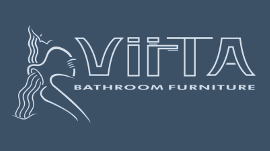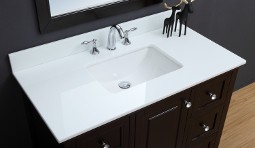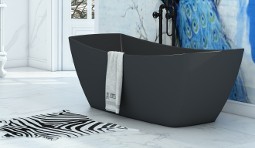
Not only is there is a shower enclosure solution for every style and size of bathroom, from contemporary frameless walk-ins to more decorative options, you can also position a shower almost anywhere in the bathroom – so long as your plumbing allows it. A corner is an obvious choice, but fitting a shower in an alcove maximises space, while positioning a tray along a long wall and teaming it with a glass panel will create a sleek and spacious walk-through shower. To avoid any slip-ups when buying and planning your shower enclosure, consider an experts guide through the essential facts you’ll need to know…
Select your style
The traditional shower has always been a square tray surrounded by glass panels and a door, which slots snugly into a corner. This still works fine, but there are many other options available, too.
1 Recessed shower enclosures
A recessed shower enclosure that fits between two walls is an excellent solution for small bathrooms, leaving the rest of the floor space free for other bathroom furniture. With the walls already in place, the only consideration needed is the type of water barrier preferred – fully enclosed or walk-in (More on walk-ins shortly.)
Door options available on fully enclosed recessed shower enclosures range from hinged, pivot and bi-fold doors to sliding doors (see below for more doors information). If floor space is limited, sliding doors are ideal.
2 Quadrant shower enclosures
Quadrant enclosures are a great space-saving alternative to rectangular or square corner enclosures, taking the shape of a quarter circle, with two sides of the same length and a rounded outer edge.
Losing one of the corners of your shower has little impact on how big the enclosure feels when you’re stood inside, but saves valuable floor space. Quadrant enclosures often have one or two sliding doors, making them an excellent option for compact bathrooms where an outward opening door would cause an issue.
3 Alternative corner options
Similar to a quadrant shower enclosure, an offset quadrant also slots neatly into a corner. How it differs is that one side is longer than the other. These have become popular as they allow for varying wall dimensions on either side
Alternatively, opt for a space-saving pentagon shower enclosure. Another corner solution, it resembles a square with one corner cut off.
Consider a walk-in shower
The popularity of the walk-in and walk-through shower has grown significantly, driven by our desire to achieve a wet-room look without the expense of tanking the floor and walls. Comprising a simple glass panel teamed with a low-profile or concealed underfloor shower tray, one end is left open allowing you to ‘walk-in’, or both ends are left open to ‘walk-through’.
Walk-in and walk-through showers are low maintenance. There are no hard-to-reach seals or runners, as they generally consist of simply a piece of glass sitting upon either a shower tray or a tiled and waterproofed floor.
They have a number of practical benefits, too. A simple panel teamed with a flush-to-floor shower tray is safe for all ages, as there is no awkward step up into the shower. Future-proofing and households with three generations living under one roof are hot topics, and easy-access walk-in showers are one solution for this situation. To create space for your walk-in, consider trading in your bath; a standard bath is 1,700mm x 700mm, which will give you enough space.
Decide on your doors
When opting for a shower enclosure, always think about the type of doors that will best fit your space and preferences.
1 Hinged doors
A hinged shower door opens into the room – something to consider when planning the layout of your bathroom. Best for spacious bathrooms, hinged doors offer wide access to the shower.
2 Pivot doors
Pivot doors rotate on a pin mechanism at the top and bottom of the door frame. They open outwards into the bathroom, but because the far edge of the door swings backwards into the shower, they need less clearance than a hinged door.
3 Bifold doors
Bifolds consist of two or more glass panels; generally one glass panel is fixed to the shower surround, while the other panels fold in on hinges. They are a good option when space is at a premium, as the door folds into the enclosure and doesn’t encroach into the bathroom.
4 Sliding doors
Available both in rectangular form, with a door and an optional side panel, or in curved ‘quadrant’ form, sliding doors are an excellent space-saving solution, as you don’t have to allow for clearance space in front of the shower. It’s important to check the actual opening size on some smaller sliding shower doors. Certain 1,000mm-wide sliding doors have less than 370mm entry width.
5 Made-to-measure doors
Custom made design is one of the fastest-growing trends in interiors, allowing you to create a solution unique to you and your space. A custom made enclosure is an ideal way of creating a statement in a large bathroom or transforming a seemingly awkward or challenging space, such as under a sloping ceiling.
6 Framed versus frameless
Aesthetically, frameless shower enclosures and screens look great. Spans of clear glass create the illusion of more space with clean lines that flow right the way through. Combined with chrome polished edges, the overall look is stylish and sleek and one that doesn’t overwhelm the space.
Check the glass thickness
All shower enclosures are made from tempered glass, also known as safety glass. Glass comes in different thicknesses, and this has a bearing on price. Cheap enclosures are often made from 4mm glass. You will generally find that when you open and close the door, it does not feel as smooth or substantial due to the lighter weight. More expensive, but usually reasonably affordable, are shower enclosures made of 6mm glass, while premium enclosures often utilise 8mm or even 10mm glass.’
But glass thickness is not the only indicator of quality. Hinges, runners, wheels and design all play a part.
Make it easy to clean
Untreated glass can suffer staining from hard-water deposits, which are difficult to remove even with regular cleaning. To keep your shower enclosure sparkling for longer, many manufacturers offer a protective coating as standard – so make sure you check.
This is an effective, invisible coating that acts as a lasting protective barrier on the surface of the glass, helping to reduce staining from hard water and chemical deposits that accelerate the ageing process, and making the glass easier to clean.
Build in your storage
Don’t forget about storage within your enclosure. You can ask your builder to create some cubbyholes or a built-in shelf.
Take a seat
An attractive seat installed inside a shower enclosure provides a secure place to rest while showering which is particularly useful for those with mobility problems. You could also consider fold-down options if space is tight or your shower enclosure is already complete.
Try before you buy
Always choose branded products as opposed to cheaper imports: this will ensure quality performance and dependable after-sales service. There is no substitute for an up close and personal inspection. For enclosures and screens, doors should feel solid, not wobble, and close tightly to prevent water escaping. Sliding doors should have a smooth, pleasing action and handles should feel sturdy and easy to grip. You can’t get this experience from looking at a brochure or a website.

































